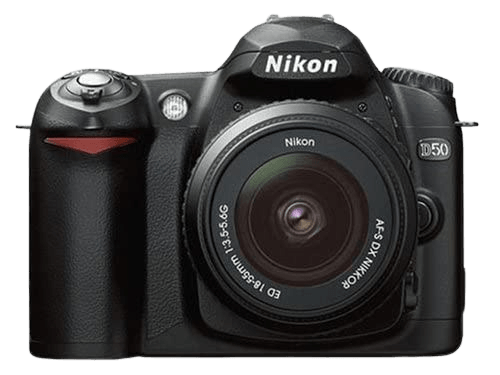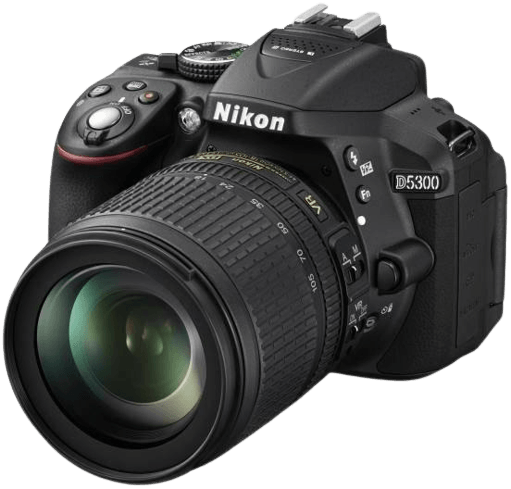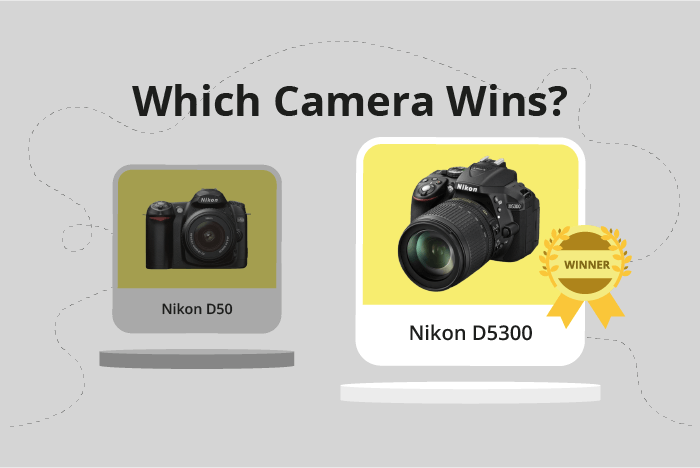Nikon D50 vs D5300 Comparison
Nikon D50

Nikon D5300

The Nikon D5300 clearly outperforms the Nikon D50 with a score of 57/100 compared to the D50’s 28/100. Both cameras are DSLRs, released in 2013 and 2005, respectively. They share similar dimensions, but the D5300 has a slight edge in size and weight, measuring 125 x 98 x 76mm and weighing 480g. The D50 is slightly larger at 133 x 102 x 76mm and heavier at 620g.
The D5300’s higher score reflects its superior features and performance. With a lower launch price of $800, it offers better value for money compared to the D50’s $1000 price tag. However, the D50’s larger size and weight may appeal to some users who prefer a more substantial feel in their hands.
Taking all factors into consideration, the Nikon D5300 is the better choice for most photographers due to its higher score, smaller size, lighter weight, and more affordable price.
Nikon D50 vs D5300 Overview and Optics
The Nikon D5300 emerges as the winner in the optics comparison, boasting a significantly higher score of 65/100 as opposed to the Nikon D50’s 34/100. Both cameras share some common specifications, such as the APS-C sensor size, Nikon F DX lens mount, and the absence of image stabilization.
The D5300’s superiority in optics can be attributed to its higher megapixel count of 24.2, compared to the D50’s 6 megapixels. This difference allows the D5300 to capture finer details and produce larger prints. Additionally, the D5300 has a faster shooting speed of 5 frames per second, which is double the D50’s 2.5 frames per second. This enables the D5300 to capture fast-moving subjects more efficiently.
Furthermore, the D5300 utilizes a CMOS sensor and an Expeed 4 processor, resulting in a higher DXOMARK score of 83 for its sensor. In comparison, the D50 has a CCD sensor and a Nikon Image processing engine, leading to a lower DXOMARK score of 55. The advanced sensor and processor in the D5300 contribute to better image quality, particularly in low-light situations.
Despite its lower score, the D50’s CCD sensor may provide better color accuracy and dynamic range in certain situations, particularly in well-lit environments. However, this advantage is minimal compared to the overall benefits offered by the D5300.
Taking all factors into consideration, the Nikon D5300’s superior optics make it the clear choice for photographers seeking better image quality, faster shooting speed, and improved low-light performance. While the Nikon D50 may have a slight edge in color accuracy, this advantage is not enough to outweigh the numerous benefits of the D5300.
Nikon D50 vs D5300 Video Performance
When comparing the Nikon D50 and the Nikon D5300 in terms of video capabilities, it is important to note that the Nikon D50 does not have any video functionality. This means that the camera cannot capture video footage, limiting its use to photography only.
On the other hand, the Nikon D5300 offers a video score of 70 out of 100, allowing users to record Full HD videos with a maximum resolution of 1920 x 1080. The camera can capture videos at a frame rate of up to 60 frames per second, providing smooth and detailed footage. Additionally, the Nikon D5300 includes a built-in time-lapse functionality, enabling users to create stunning time-lapse videos without the need for external equipment or software.
Taking these factors into consideration, it is clear that the Nikon D5300 is the superior choice for those interested in video capabilities. The Nikon D50, lacking video functionality, is best suited for users who only require a camera for photography purposes.
Nikon D50 vs D5300 Features and Benefits
The Nikon D5300 outperforms the Nikon D50 in features, with a score of 46/100 compared to the D50’s 10/100. Both cameras share some specifications, such as the absence of a touchscreen and Bluetooth connectivity. Both also have Wi-Fi capabilities, allowing for easy image transfer and remote control.
The D5300 excels in several areas, particularly in screen size and resolution. Its 3.2-inch screen is significantly larger than the D50’s 2-inch screen, providing a more comfortable viewing experience. The D5300’s screen resolution of 1,037,000 dots far surpasses the D50’s 130,000 dots, resulting in a sharper and clearer image display. Additionally, the D5300 features a flip screen, facilitating shooting from various angles and enhancing the camera’s versatility. The inclusion of GPS in the D5300 is another advantage, making it convenient for photographers to geotag their images and track locations.
The Nikon D50, however, does not offer any particular advantage over the D5300 in terms of features. It has a smaller screen, lower resolution, no flip screen, and lacks GPS. Its Wi-Fi capability is its only shared strength with the D5300.
Considering the points discussed, it is evident that the Nikon D5300 is the superior camera in terms of features, offering a larger screen, higher resolution, flip screen, and GPS functionality. The Nikon D50, with its limited features, falls short in comparison. Therefore, photographers seeking a camera with more advanced features should opt for the Nikon D5300, while those who prioritize simplicity and do not require advanced options may find the Nikon D50 sufficient.
Nikon D50 vs D5300 Storage and Battery
The Nikon D50 wins in storage and battery with a score of 51/100, while the Nikon D5300 scores 29/100. Both cameras have one memory card slot and do not support USB charging. However, the D50 accepts SD cards, while the D5300 is compatible with SD, SDHC, and SDXC cards.
The D50 excels with a significantly longer battery life of 2000 shots, compared to the D5300’s 600 shots. This advantage is due to the D50’s more efficient EN-EL3 battery. On the other hand, the D5300’s EN-EL14a battery results in shorter battery life.
The D5300’s edge lies in its broader range of compatible memory cards, allowing for more storage options. Nevertheless, the D50’s superior battery life makes it the better choice for extended photography sessions. The D5300’s storage advantage may be beneficial for some users, but it does not outweigh the D50’s impressive battery performance.
Nikon D50 vs D5300 – Our Verdict
Are you still undecided about which camera is right for you? Have a look at these popular comparisons that feature the Nikon D50 or the Nikon D5300:

